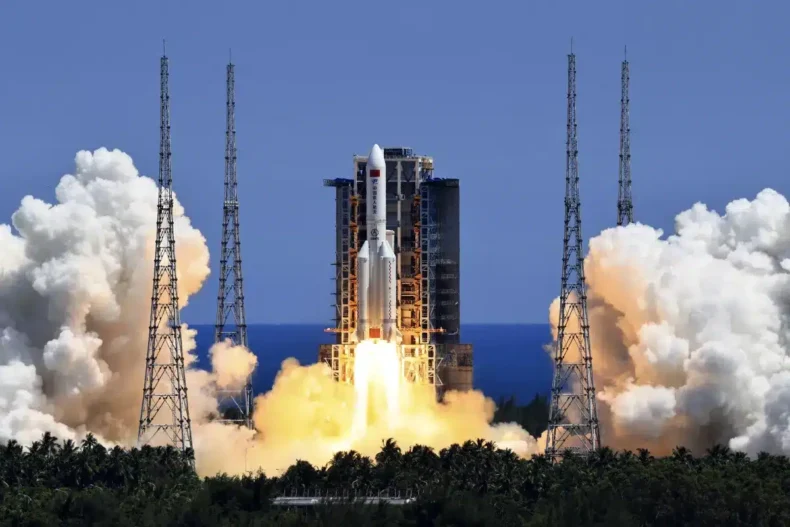Another Chinese Long March 5B rocket debris will fall to Earth once again in soon, in a yet-to-be-determined location.
The third and final module of the Tiangong space station was launched by the China Manned Space Agency (CSMA) on a Long March 5B heavy-lift rocket on Monday, October 31. Similar to earlier Long March 5B flights, China did not conduct a controlled deorbit of the rocket’s core stage following the deployment of its cargo. Therefore, a 23-ton Chinese rocket body will once more crash to Earth in the coming days above a yet-to-be-unidentified site.

During a briefing on Wednesday that covered the forthcoming space debris fall and what could be done in the future to avoid such incidents, Ted Muelhaupt, a consultant with The Aerospace Corporation’s Corporate Chief Engineer’s Office, said, “Here we go again.”
Muelhaupt emphasized that no one has to change their lives because of this but he also stated that “88% of the world’s population is at risk, and thus 7 billion people are at risk” from Chinese space debris possibly crashing on them.
This incident is one of many. Another Long March 5B survived the descent through Earth’s atmosphere and fell into the Indian Ocean in July, weighing between 5.5 tonnes and 9.9 tonnes (5 to 9 metric tonnes). After China’s space agency failed to execute a controlled deorbit in April 2021, another Long March 5B crashed into the Indian Ocean. Pieces of the rocket’s core stage reportedly fell to the ground in Ivory Coast in 2020, following the rocket’s first launch.
More people are demanding the creation of international regulations or conventions to stop these uncontrolled Chinese reentries as they happen more frequently. During today’s briefing, Marlon Sorge, Executive Director of The Aerospace Corporation’s Center for Orbital and Reentry Debris Studies (CORDS) stated that the legal status of these kinds of reentries is ambiguous under international law.
The panel of specialists from the Aerospace Corporation particularly stressed that they weren’t trying to dramatize the situation or spread fear. The answer, according to Muelhaupt, is that you have a much better chance of winning the lottery tonight than being struck by this object. “Six in ten trillion represents the danger to a person, which is a very small number.”
The majority of rockets are built so that their core stages crash shortly after takeoff into the sea or over uninhabited territory, or, in the case of SpaceX spacecraft, return to Earth for secure landings. However, China allows the Long March 5B core stage to remain in orbit until the drag causes it to crash in an uncontrolled manner
The national space agencies of China or any other recognised governmental organization have not responded to The Aerospace Corporation’s ongoing monitoring and notification of falling Long March 5B rocket bodies. Muelhaupt claimed that although he has heard broad remarks in the West promoting this “needlessly,” he is not aware of “any direct comment about Aerospace by the Chinese.” In the past, but mainly not, according to Sorge, the Chinese government “made some statements in the press.”
The Long March 5B rocket was deployed from the Wenchang Satellite Launch Center on October 31 at 3:37 a.m. (EST). Within 25 minutes of liftoff, the Mengtian module was in low Earth orbit, and the mission was deemed successful.
Mengtian used its own propulsion to match orbit and connect with the Tiangong space station, which is currently in orbit measuring roughly 380 by 387 kilometres. This occurred at 4:27 p.m. (EST), just under 13 hours after the launch.
The arrival of Shenzhou-15 at Tiangong and the formal handover of China’s first crew will mark the beginning of the operational phase of the space station. Tiangong will be engaged in scientific research by China for at least ten years, including international research through a partnership with UNOOSA. In the future, it could be possible to accommodate foreign astronauts as well.
China intends to enhance Tiangong’s capabilities in the future. In late 2024 or early 2024, another launch of the Xuntian optical module, a co-orbiting, “Hubble-class” space survey telescope, is anticipated. Xuntian has a camera with a 2.5 gigapixel resolution and a two-meter aperture. It plans to survey about 40% of the sky during a ten-year period using its wide field of view. Additionally, it will be able to dock with Tiangong for maintenance and repairs. According to Chinese space authorities, the space station may be expanded to three to six modules, with hopes that other nations may join forces as well.













